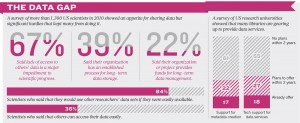 This article was mentioned in the “Third Space, Third Place: libraries at the center of campus life” presentation I attended yesterday and is an interesting read.
This article was mentioned in the “Third Space, Third Place: libraries at the center of campus life” presentation I attended yesterday and is an interesting read.
A few passing students do a double take as Sayeed Choudhury waves his outstretched right arm. In his crisply pressed dress shirt and trousers, the engineer looks as if he is practising dance moves in slow motion. But he is really playing with astronomical data.
Standing in a US$32-million library building opened last year at Johns Hopkins University in Baltimore, Maryland, Choudhury faces a 2-metre-by-4-metre ‘visualization wall’ of television screens. Pointing with his arm, he selects a picture of the Ring Nebula out of 40 images from the Hubble Space Telescope. Choudhury spreads his hands in a welcoming gesture and the nebula’s rim of glowing orange gas fills the frame.
This wall is the brainchild of computer scientist Greg Hager and Choudhury, who directs digital research and curation at the library. For $30,000, they and their team patched together monitors, processors and the Microsoft Kinect system that recognizes arm and body gestures. They placed the wall in the library last October as an experiment, allowing students and researchers to explore a few of the university’s data sets, from star systems to illustrated medieval manuscripts.
“As we create more and more digital content, there’s a question of how do you get people to even realize we have it and then interact with it in new ways,” says Choudhury, who thinks that the wall is starting to catch on. One chemical engineer wants to use it to visualize and manipulate molecules, and astronomers hope that it could help to train students in categorizing galaxies. By providing alternative ways to explore and share data, says Choudhury, the wall “is a new form of publishing”.
Around the world, university libraries are racing to reinvent themselves to keep up with rapid transformations in twenty-first-century scholarship. They still do a brisk business in purchasing books, licensing access to academic journals and providing study spaces and research training for students. And libraries are increasingly helping teachers to develop courses and adopt new technologies. But for working scientists, who can now browse scientific literature online without leaving their desks, much of this activity goes unseen. For many, libraries seem to be relics that no longer serve their needs.
Read the full article @ nature.com.